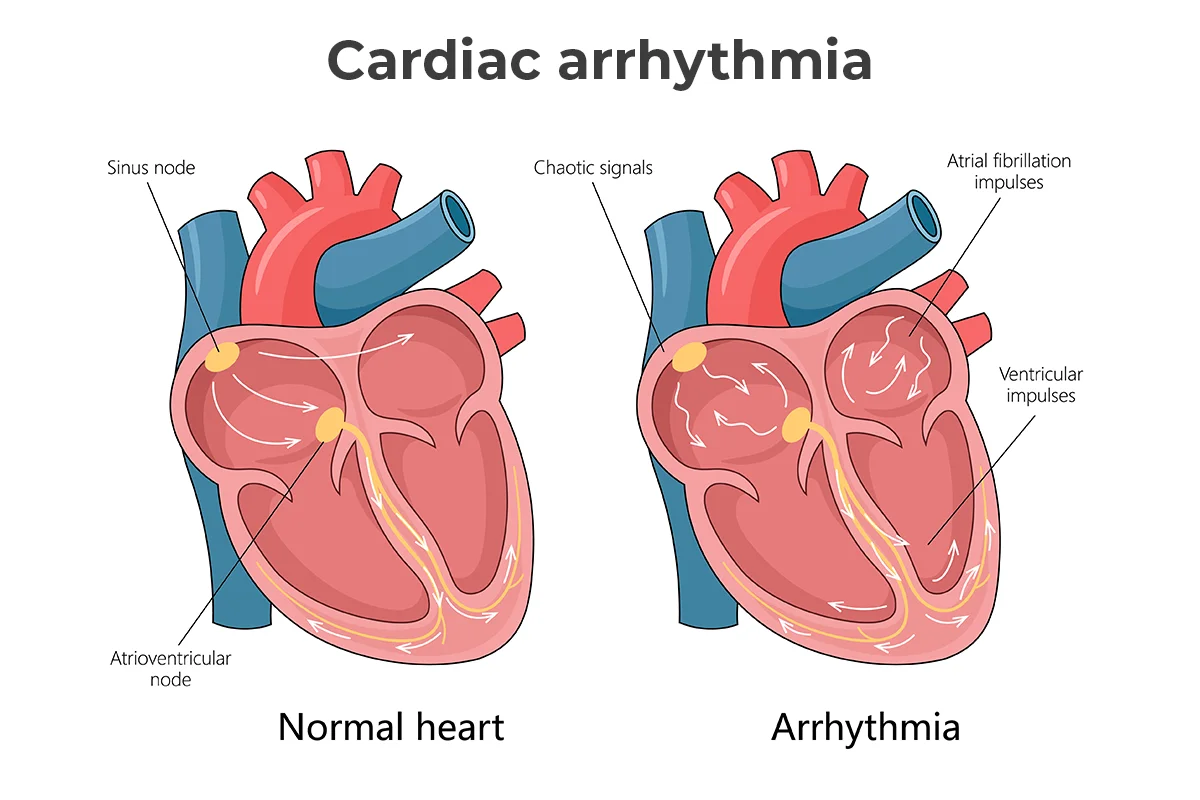Arrhythmia
Find a doctorAn arrhythmia is a problem with your heart rhythm. Your heart may beat too fast, too slow or with an irregular rhythm. At Atrium Health Floyd and Harbin Clinic, our heart specialists offer expert arrhythmia diagnoses and treatments to help get your heart beating in a healthy pattern..

Healthy heart rhythm pattern and abnormal heart rhythms.
What is an arrhythmia?
An arrhythmia occurs when your heartbeat is out of rhythm. It causes an abnormal heartbeat that’s too fast, too slow or erratic.
Some arrhythmias are harmless and don’t require treatment. But serious arrhythmias can increase your risk of cardiac arrest. These potentially life-threatening heart rhythm changes require treatment.
Causes of arrhythmias
Things that affect the electrical signals that control your heartbeat can lead to an arrhythmia. An arrhythmia may occur due to:
- Malfunctioning of nerve cells in the heart that produce electrical signals
- Electrical signals that don’t travel through the heart as they should
- Another part of the heart making electrical signals when it shouldn’t
Arrhythmia symptoms
An arrhythmia doesn’t always cause symptoms. Heart palpitations are the most common sign of an arrhythmia. Your heart may feel like it’s:
- Fluttering
- Skipping a beat
- Beating too hard or too fast
- Pausing between beats
Other symptoms of arrhythmia may include:
- Chest pain
- Dizziness, lightheadedness or fainting
- Fatigue
- Shortness of breath
- Sweating
- Weakness
Arrhythmia types
Arrhythmia may be classified according to the speed of your heartbeat and where the arrhythmia starts. Tachycardia occurs when your heart beats faster than 100 beats per minute. Bradycardia occurs when your heart beats slower than 60 beats per minute.
Sometimes, these rhythm changes are normal and harmless, such as during intense exercise. But sometimes, they can be dangerous.
Types of atrial arrhythmias
Atrial arrhythmias start in your heart’s upper chambers (atria). Types include:
- Atrial fibrillation (AF or AFib): The most common arrhythmia, AF causes a fast, irregular heartbeat. AF increases your risk of stroke.
- Atrial flutter: Atrial flutter is when your heart beats too fast but with a steady rhythm.
- Premature atrial contractions (PAC): PAC occurs when your heart’s upper chambers contract sooner than they should or when there’s an extra contraction.
- Sick sinus syndrome (SSS): SSS causes your heart to beat too slow and then too fast.
Types of ventricular arrhythmias
Ventricular arrhythmias start in your heart’s lower chambers (ventricles). Types include:
- Heart block: Also called sinus block, this arrhythmia occurs when electrical signals can’t travel from your atria to your ventricles. Your heart may beat too slowly or skip beats.
- Premature ventricular contractions (PVC): PVC occurs when your heart ventricles contract sooner than they should or there’s an extra contraction.
- Supraventricular ventricular tachycardia (SVT): SVT causes irregular heartbeats that start above the ventricles.
- Ventricular fibrillation (VF): With VF, the ventricles quiver or twitch erratically instead of squeezing. VF can lead to cardiac arrest.
- Ventricular tachycardia (VT): VT is a fast, irregular heartbeat that starts in the ventricles.
Arrhythmia diagnosis
Your health care provider will ask about your symptoms and medical history. They will also listen to your heart during a physical exam. An electrocardiogram (ECG/EKG) that records your heart’s electrical activity is a common test to diagnose an arrhythmia. Your doctor may also order other tests, such as:
- Blood tests to measure potassium, electrolytes and hormones
- Electrophysiology (EP) study to provide a more detailed analysis of your heart’s electrical activity
- Heart imaging scans, such as CT scan or MRI, to check heart function and structure
- Heart monitor, such as a Holter monitor or implantable loop recorder, to record your heart activity while you do daily activities
- Tilt table test to help identify the cause of fainting spells by monitoring your heart rate and blood pressure when your body changes positions
Arrhythmia risk factors
Certain health conditions may increase your chances of developing an arrhythmia. These conditions include:
- Atherosclerosis (hardening of the arteries) and coronary heart disease
- Congenital (present at birth) heart defect
- Diabetes
- Heart attack, heart failure or heart valve disease
- Heart surgery
- High blood pressure
- Obesity
- Sleep apnea
- Substance use disorder (addiction), including smoking cigarettes
- Thyroid disease
Arrhythmia prevention
Actions that can help lower your chances of developing an arrhythmia include:
- Cutting back on caffeine and alcohol
- Managing conditions like high blood pressure, diabetes and sleep apnea
- Maintaining a healthy weight through physical activity and a heart-healthy diet
- Seeking help to quit smoking or using other drugs
Heart services
Personalized heart care from experts you trust
Get the MyAtriumHealth app
Get test results, message your provider & more.